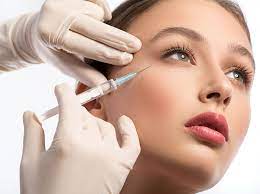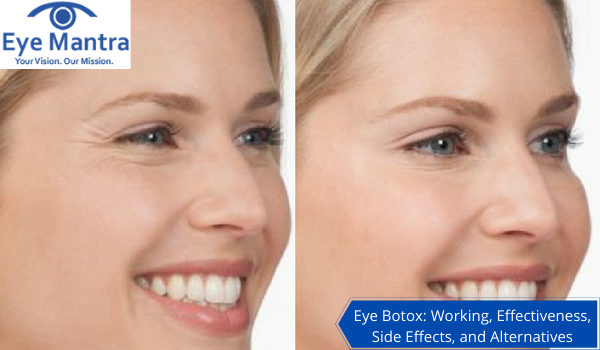Contents
What Are Eye Botox?
You must have read about Botox Cosmetic in advertisements, celebrity gossip magazines, blogs, or heard about it from your friends. When most people think of Botox, they think about injections and other cosmetic invasions. And there are a lot of misconceptions about Eye Botox and how it is used. But many times this famous medical treatment is used to treat several serious conditions.
“Botulinum toxin”, commonly called Botox, works by freezing or blocking the nerve impulses that cause the muscles to contract, minimizing the appearance of “dynamic” wrinkles. Generally, for the face, it is injected into the upper third part, or specifically, the “11” lines between the brow, the crow’s feet, and the horizontal forehead creases.
Ophthalmologists use Eye Botox to treat some severe conditions that impact vision. These may be Lazy Eyes, Dry Eyes, Eyelid Twitching, Ocular Migraines, Drooping Eyelids, and/or Excessive Tearing of eyes.
However, many countries and their organizations, especially the United States Food and Drug Administration (FDA) have not approved the use of Botox under the eye for cosmetic purposes.
There are some risks and side effects of Botox that are important to understand. But mostly, Botox injections are safe answers to symptoms of several medical conditions.
In this article, let’s elaborate on what is currently known about using Botox under the eye. Its possible side effects and alternatives to this procedure.
How Does Eye Botox Work?

Vials of Botox have three main ingredients. Botulinum Toxin Type A, Human Albumin, and Sodium Chloride. The active component is the Botulinum Toxin A has the greatest effect. Botox is used for three main purposes. They are:
- Controlling muscle spasms,
- Controlling severe underarm sweating,
- Cosmetic improvement.
When injected into a muscle, Botox blocks the nerve impulses that cause that particular muscle to shrink. The muscle cannot move now, and this reduces the development of wrinkles.
Botox can only reduce wrinkles in those parts of the face that contract. Doctors will normally use it on the frown lines between the eyebrows, called “Glabellar Lines”, as well as on crow’s feet at the sides of the eyes, and lines in the forehead.
Botox is, however, not a permanent solution to wrinkles. Within 3–6 months, it stops blocking the nerve impulses, and the muscles begin to contract. A person will need further injections at regular intervals to maintain results.
How Effective Is Botox Under The Eyes?
Injecting Botox to treat bags or dark circles under the eyes has not been approved in many countries. For this reason, few studies have been conducted about this use, and doctors are unsure how effective it may be. Except only a few and far between.
Their results suggest that injecting Botox can make the lower eyelid appear fuller and plumper, helping to reduce wrinkles and bagginess.
The effects of varying amounts of Botox in the lower eyelid were also measured. The results on those patients were the strongest who received 8 units of Botox, but they also had the most intense side effects. Currently, little other research exists regarding Botox injected under the eyes.
Side Effects of Eye Botox
Possible Botox side effects include pain in the area where it has been injected, infection, inflammation, swelling, redness, bleeding, and bruising. Some of these symptoms may be due to allergies. Other allergy symptoms are itching, wheezing, a rash, red welts, asthma, dizziness, and faintness. Get in touch with your Eye Doctor, immediately if you have any breathing issues or a faint or dizzy feeling.
Also, dry mouth, headache, fatigue, and neck pain have been reported. There may be some other side effects as well, such as numbness, droopy eyelids, muscle spasms or twitching, and migration of the substance.
Because Botox is not an anaesthetic, numbness as an absence of physical sensation is not an issue with Botox. Numbness due to the inability to move a muscle is an issue for some people.
Muscle spasms in the area of the Botox injections do not occur as long as the Botox is effective. After all, Botox is supposed to treat spasms related to benign essential Blepharospasm. The area surrounding the eyes is delicate. So the risks of having Botox injected around the eyes may include:
- Difficulty closing the eyes,
- Eye drooping,
- Numbness in and around eyes,
- Swelling of the lower eyelid.
Below are some of the other general side effects of Botox:
- Bleeding,
- Bruising,
- Dizziness,
- Fainting,
- Pain at the injection site,
- Redness.
People who have certain chronic conditions should not be given Botox injections. These conditions include Amyotrophic Lateral Sclerosis, otherwise called Lou Gehrig’s disease, Myasthenia Gravis, and the related Lambert-Eaton syndrome.
Tips to Avoid Botox Side Effects
Following the below tips will minimize or prevent most Botox side effects. Especially since it would be extremely rare for the patient to experience all of them together:
1) Make sure your Eye Doctor is highly experienced and an expert at Botox injections and is a respected medical professional. Do not get such things done by your salon stylist. Who may not have emergency equipment or sufficient medical knowledge if something went wrong. Some patients have been reportedly administered injections that were over-or under-diluted with saline, as well as counterfeit solutions that didn’t contain Botox at all.
2) Before getting injected, tell your practitioner about any health problems or allergies you have.
3) Tell your doctor about medications, supplements, vitamins, herbal preparations you take, since some blends of these supplements with Botox could cause serious side effects. It’s especially important to mention injected antibiotics, muscle relaxants, allergy or cold medicines, and sleep medicines.
4) Follow your doctor’s pre-and post-injection instructions very carefully.
5) Once done, report all side effects — especially those that are bothering you or won’t go away.
It takes a few days to see the final effects of the injections.
Alternatives To Eye Botox
Home treatments and other medications can be effective at reducing under-eye bags, dark circles, etc. These are good alternatives to getting Botox under the eye.
Especially when you consider the possible side effects and the risks involved. For example, methods that reduce under-eye wrinkling can be very different from those that decrease dark circles.
First, you should examine your daily habits to know how much they may be contributing to bags and wrinkles under the eyes. The following tips may help:
- Get enough rest and sleep, which is generally estimated to be 7 or 8 hours a night.
- Avoid treating seasonal allergies that cause puffy eyes with over-the-counter medications, such as antihistamines.
- Abstain smoking.
- Avoid excess salt and sodium in the diet. It causes the body to retain water, leading to a buildup of fluid and puffy skin.
- Sleep with the head slightly elevated. So that fluid doesn’t collect under the eyes.
- Refrain from excess sun exposure and wearing appropriate sunscreen when going out.
Some cosmetics also help to soften and smoothen the skin under the eyes. For example, if you are concerned about eye puffiness, you may try using an eye cream that contains caffeine. Caffeine is an eye cream that helps tighten skin and reduce puffiness. If dark circles are the point of concern, creams made specifically for the under-eye area may help.
Some fillers can be injected to add volume to the under-eye area. This contains ingredients that can reduce the appearance of wrinkles and dark shadows on the face.
Laser treatment is one more option. They stimulate the growth of collagen in the skin, making it appear tighter. However, laser treatments can be quite expensive.
Scope for Eye Botox
Injecting Botox under the eye is not an approved use. Botox is injected in areas where there is significant muscle movement to reduce the appearance of wrinkles. It may not be as effective when injected under the eyes as when used in the jawline, for example.
Therefore, you are advised to, first, thoroughly discuss the treatment, risks, and benefits with an experienced doctor before having Botox injected under your eyes.
To know more about Botox or other eye surgeries, please visit Eyemantra. Or you can email us at [email protected].
We specialize in Cataract Surgery, Specs Removal, Retina Surgery, and much more.
To book an appointment with expert ophthalmologists with many years of experience, call Now at +91-9711115191
Related Articles:
Phacoemulsification Surgery: Diagnosis, Process, Benefits & Risks: All you Must Know
Retinal detachment: What is it, Causes, Symptoms, Surgery & treatment in Delhi



